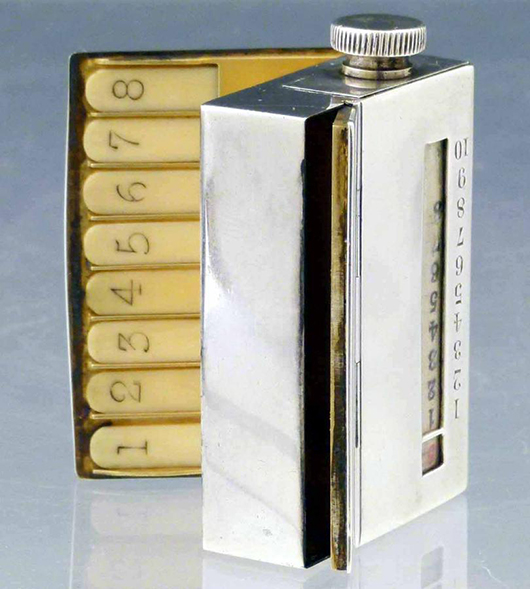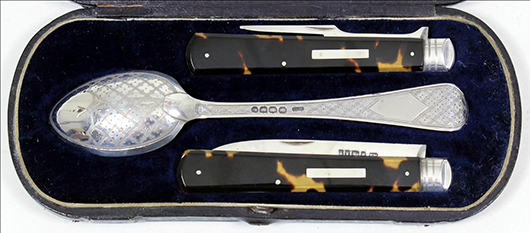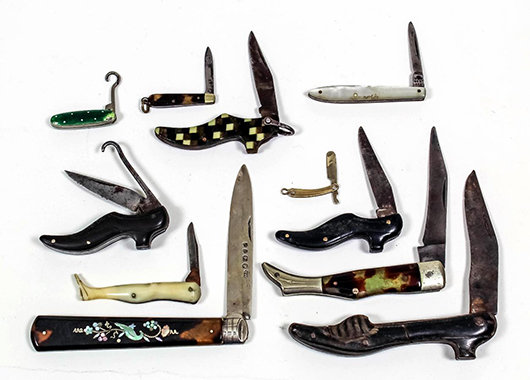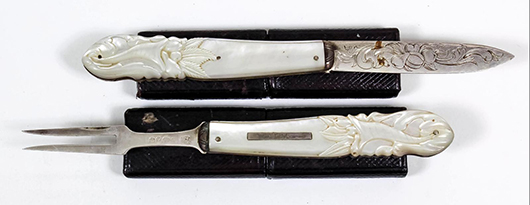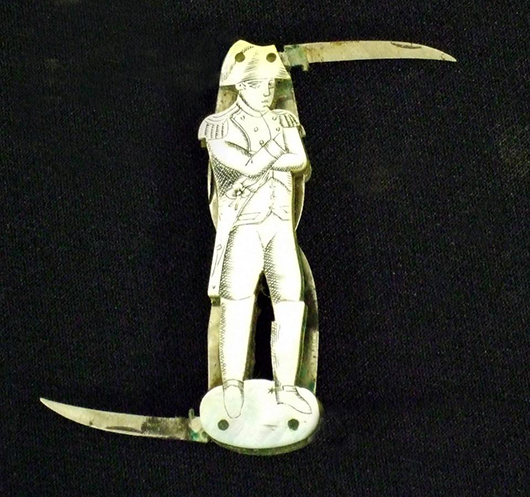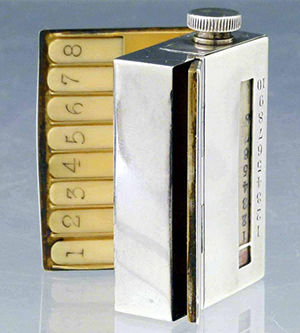
LONDON – Spotted in my local saleroom: a patented silver combined shooting butt selector and vesta case by the London maker, J C Vickery. Permit me to explain. In a driven grouse or pheasant shoot, each participant chooses a numbered ivory ticket. Rotating a dial on the selector gizmo directs each gun to the butt (position) to take during that drive. Subsequent turns of the dial allocate different positions at later drives so every gun gets a fair chance of bagging a bird on the day.
The added novelty with this particular version, however, was a hinged vesta compartment with striker that ensured a smoker’s matches remained dry while out in the field. Assayed in 1907, the pocket-sized case was estimated at £250-350. I’d never seen one before and neither had many others. It sold for £3,300.
I can’t resist a gadget, I have drawers full of the things, needless to say most of them now redundant. Taking much of the strain lately is my smartphone and the apps – both the purchased and free varieties – that hog so much of its now limited capacity. I can use it to help me read silver hallmarks or play chess, making it what must be the ultimate gadget. But what was the first?
Cue lengthy debate, because history is littered with them. High on my list, though, has to be the humble penknife. Time was when men – and women – carried one, and their purpose was manifold.
There were pocket knives for anglers, sportsman, gardeners, smokers, Boy Scouts, motorists, handymen and even one specifically for the champagne drinker. In the 1920s, this novel device might have contained a couple of blades; a hook-shaped implement for cutting the bottle’s seal, buttonhook and corkscrew. My trusty 1926-27 Army and Navy catalog had a nickel silver example that retailed at eight shillings and sixpence (42 1/2 pence).
The folding knife has been around since Roman times. Excavations have uncovered charming examples with elaborately carved handles, while the pocket knife whose blade folds into the handle, was invented in the 16th century. It was originally used for putting the points on the business end of quill pens, hence the name.
Sheffield has been the home of cutlery for almost a thousand years. Edward III (1312-1377) listed a Sheffield knife in his will when entombed in the Tower of London, and in the 1380s, Chaucer wrote about a Sheffield knife in the Reeves Tale. By the 1580s, Sheffield penknives were being recommended as the first choice for teacher in “The Writing School-Master.”
A breakthrough came in 1740 when a new technique was developed to produce high-quality steel. Sheffield clockmaker Benjamin Huntsman wanted better clock springs, and after years of experimenting in secret, he perfected a process to produce crucible steel. The invention turned the city into a world leader in the production of high-quality cutlery.
Huntsman’s crucible steel was also ideal for both the blades and the springs of pocket knives and other highly specialized instruments such as surgical knives and cut-throat razors. Very quickly an industry within an industry boomed, and Sheffield pocket knives – as well as much larger sheathed hunting knives (the subject of a column to itself) – were being exported across the globe.
From perfecting the simple folding knife with a spring and one blade, cutlers realised that more springs could be added, together with more blades and various tools fitted at each end of the springs.
The ingenuity of skilled cutlers meant there was tremendous scope for variation and as a demonstration of the cutlers´ skills, penknives grew ever more complex, including as well as corkscrews and button hooks, such tools as leather punches, nail files, scissors, magnifying glasses, toothpicks, cigar cutters and so on.
Delicate penknives, meanwhile, were also produced in a vast range of styles and varieties catering for almost every user and occasion. Some of the daintiest were intended for use in a lady’s boudoir, or her portmanteau, while others, often smaller still, and often in silver, had a hook so they could be hung from a chatelaine – the collection of everyday necessities a woman wore, hanging from a belt. The blade was needed, for example, to peel an apple, while a tiny corkscrew was there to pull the corks from perfume or medicine bottles.
Fruit knives offer huge scope to the collector. French cutlers were first to produce folding knives with silver blades which, unlike their steel counterparts, were not stained by fruit acid. Fruit was a luxury in the 19th century, so the knives used to cut it reflected the social standing of their owners.
In their simplest form, most had a single folding blade and a handle made from mother of pearl, usually engraved with motifs reflecting the purpose of the knife. At the other end of the price spectrum, the very finest examples had gold blades decorated with bright-cut engraving, often with trailing vines. Beautifully executed handles were decorated with inlays of gold and semi-precious stones and many can be found engraved with their owners’ initials.
Prices start from a few pounds for a simple example to many hundreds for the best. Fruit knives with little added extras are particularly sought after. Look for those in their original cases with long, thin pointed blades intended to remove pips from fruit and matching forks.
Among the most amusing penknives are novelties such as those shaped as a woman’s leg or shoe. Others are big and workmanlike and have handles made from various woods, horn or bone, sometimes carved to resemble stag horn. They are the kind of penknives to be found lying in the bottom of tool boxes in auctions or at rummage sales.
The 20th century saw an increase in the use of penknives for commemorative occasions, particularly coronations, and as souvenirs from seaside resorts. Most use plastics such as ivorine which can imitate ivory or dark wood and fool the uninitiated.
In the last 20 years or so there has been a huge upsurge in interest among collectors, and many of the companies founded in Sheffield to produce traditional penknives continue to thrive today making limited edition examples intended solely for the collectors’ market. Such examples in their plush cases are intended as cabinet pieces, not as working tools.
The collector of old penknives should buy only those examples whose folding mechanisms are still in good, crisp working order and whose blades are complete and free of damage. A blade that does not reach the end of its slot means it has been broken and ground back to its original shape sometime in the past.
The more decorative knives with a greater number of blades and tools are more valuable than plain, simple examples, but prices remain affordable.
Rusty blades can be cleaned with fine wire wool and penetrating oil and then polished with soft paper. The mechanism should be kept free with a careful application of refined oil, while handles in natural material should be treated with a little almond oil.
With a little care, grandfather’s prized penknife – the one you saw him use to cut his plug tobacco – will give you a lifetime of service before you hand it on to your grandchild.
# # #

ADDITIONAL IMAGES OF NOTE
